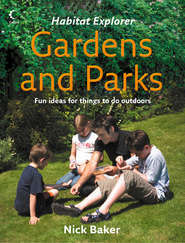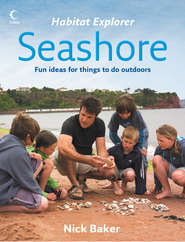По всем вопросам обращайтесь на: info@litportal.ru
(©) 2003-2024.
✖
Rivers, Ponds and Lakes
Автор
Год написания книги
2019
Настройки чтения
Размер шрифта
Высота строк
Поля
> some suitable netting
> needle
> thread
> strong but bendy wire
> wire cutters
> pliers
> bamboo cane
> gaffer tape
1 Decide on the depth of your net. Aim for it being about as deep as it is wide and allow extra fabric to fold over at the top a couple of times. Stitch the turned-down fabric to make a channel. Fold the fabric in half. Stitch along the bottom and up the open side as far as the channel and turn the inside out.
2 Thread the wire through the channel at the top of the bag. For size, you should aim for 20–30cm across. Anything bigger may seem like a better way of catching more, but get a big net full of weed and mud and nobody but Mr Universe would be able to haul the thing in!
3 Cut off the excess wire so that you are left with 7.5cm sticking out at each end. You might want to ask an adult to help you with this next bit – twist together the ends of wire. Pliers can be helpful.
4 Push them into the end of the bamboo cane and . . .
5 . . . use a good length of gaffer tape to keep the cane in place. Now you’re ready to dip!
Handy stuff for exploring with
A naturalist needs nets and they come in different sizes and styles for different jobs. A stout-framed one with coarse netting is perfect as a pond-dipping net; a lighter one with a delicate mesh is handy for catching winged creatures. A butterfly net is useful for catching . . . well, butterflies!
Binoculars These are expensive and one of the few things that you cannot make yourself. But they are well worth the investment and there are many prices to meet different purses. They are especially useful for bird watching, but a close focusing pair are brilliant for watching dragonflies.
Bucket Great for the bigger stuff.
Magnifying lens Another bit of kit that is worth buying. It will turn a mite into a monster.
Plastic pots, trays and plastic aquariums Brilliant for sorting, separating and observing your catches or collecting your specimens in. The clear ones are even more useful in a watery environment as they let you look at the animals from under the surface. Bags are handy lightweight alternatives to pots; they are also useful for keeping plant specimens fresh.
Sieves and tea strainers These are very handy for smaller, close-up work and sorting out creatures once you have caught them. Make them even more useful by strapping the handle to a bamboo cane with gaffer tape (see page 8), rather like the yogurt pot on a stick on page 31.
Stout stick I find this useful as an extra leg, especially when wading. You can use it to test the water’s depth or if you are leaning out with your net, a stick is something that you can lean on for support. With a little tape or string, you can construct a makeshift net handle, too.
Wellie boots Okay, so they aren’t fashionable, but they are a lot cooler than a shoe full of squelchy water or mud.
Puddles (#ulink_7a7ad43a-e8d3-5231-b78d-db3f040c1462)
Have you ever left a bucket of water out in the garden or peered into a water butt and noticed it full of wiggly things? Life has appeared as if by magic where before there was none. But this is far from a spontaneous happening. What you have just seen is the wonderfully efficient way that nature has of seeking out and colonizing a new habitat. Even a puddle, assuming it doesn’t just evaporate before things get going, can be home to all manner of weird and exciting life forms.
Try this experiment. It is called Thienemann’s tank and is named after a German scientist who first noticed this phenomena in his garden. Mr Thienemann set out to look at how aquatic invertebrates (that’s to say, those animals without a backbone that live in water) colonize watery habitats. He left a tank of water in his garden and then every now and again checked it for life. Over eight years he recorded 103 species, which turned up without any aid.
Many species, such as mites and snails, can hitch a lift on others, and some, such as beetles, bugs and dragonflies, all at some stage in their lifetime have wings that enable them to disperse and colonize fresh habitat. But some of Mr Thienemann’s finds were totally aquatic – they could only survive in water. So how did they get there?
If you try Thienemann’s experiment, you will be creating a new habitat. The method is simple – take as big a tank or tub as possible and fill it with water. Then check it every week and record everything you see living in the water. You will almost certainly need the help of a good field guide or even your local museum to help you identify everything.
You must also look very carefully as some of the creatures will be very small and not at all obvious at first glance. If you have a hand lens or a microscope, this may come in very useful. Try to keep a diary. Draw pictures of anything that arrives and add the date when you noticed it.
Some amphibians, particularly toads, can breed in surprisingly small puddles of water.
Water fleas, or daphnia, are not fleas at all; they just twitch and jump about like them. They are one of the most common of the freshwater crustaceans.
Mosquito larvae are very quick to colonize tiny little puddles and pools of trapped water. The contents of water butts, old car tyres, even jam jars, soon start to twitch with the eggs, larvae and pupae of this infamous insect.
Water boatmen, like many adult water insects, actually have wings folded away and are excellent aeronauts. This means they are some of the first colonizers of a new pond, magically appearing, seemingly out of nowhere.
Aeronauts and aquanauts
Now you can understand how tiny little things like water fleas can turn up in a puddle, but what about larger pond life, such as beetles, water boatmen and pond skaters? If you look in a newly dug pond or a cattle trough, you are more than likely to see a multi-eyed, six-legged water bug go rowing past. How did it get there? Well, wonder no more; the answer is that it arrived by air. To prove this, follow the steps opposite.
Some aptly named water boatmen – their back legs look like oars and bodies like hulls.
Fab facts
* These insects are thought to be very sensitive to the kind of light that is reflected off the surface of water, such as ponds, lakes and streams. So when they go buzzing about above us in the air, how do they find their new home? It turns out they are able to see the light as it is reflected from the water’s surface.
* The sad thing is that this worked perfectly well before mankind came along and confused things! Car bonnets and roofs look similar to water as they reflect the same kind of light and many pond insects, including water boatmen and water beetles, try to touch down in our car parks and on our roads – both fairly unfriendly places to end up dazed and spinning on your back!
1 A big water boatman is an ideal insect to catch. It is big, so you can observe it a lot easier, and it is also easy to identify as an adult. Water boatmen are the ones with the silvery white backs, which is easy to see when they are flipping around in your net.
2 Gently remove the insect from the net. Try to lift it without squeezing, as it can deliver a painful bite with its stabbing mouth parts. Hold it in the flat palm of your hand. It may leap about a bit at first, but it isn’t in pain, or suffocating – trust me!
3 It will soon settle down with it’s back facing up, so watch it carefully. The next bit usually happens in a couple of minutes, depending on how sunny or hot it is. Watch for it to open the top of its back and start pumping its abdomen back and forth. Any second now, the boatman will unfold its wings and buzz off to find a new pond. The mystery is solved – most adult bugs have leathery wings and are good fliers. This is handy as they can check out new homes, or simply make the most of temporary ones!
Take it further
* This is just a fun little experiment that helps us know how water boatmen, also known as backswimmers, orientate themselves in their underwater world.
* Take a small jar of water with your boatman in it to a dark room. Turn out the lights and shine a torch in the jar from underneath. What happens? Your water boatman – and here you must remember its other common name – has become a front swimmer. This proves they use light direction to orientate themselves in the water and not gravity.
Handy stuff: an aquarium
Scooping some strange and alien life forms out of the water, looking at them for a few minutes in a tray and then putting them back can be just a little dissatisfying. Yes, if you are lucky, you may see gills twitch, a bit of scrabbling around and, if you are a good naturalist, you may be able to put a name to the creature. But surely there is more to their lives than just that? How fast do they grow? How do they eat? Do they change colour? What do they turn into?
With just a bit of knowledge about how to set up an aquarium properly you can take a little piece of the pond or stream and some chosen subjects back home with you. It is only by gazing into their wondrous little lives day in, day out that you really get to know them and study them properly.
Remember, however, that once any living creature has been lifted out of its home in your net, it is your responsibility. Be sure not to over-stock your tank and not to mix predators with prey as almost certain carnage will result. It’s all about balance. Try to resist having too many individuals of any one species. One or two snails are good, but if they get happy, they will breed and eat all your plants. Lots of predatory fish or beetles look good, but may kill other, more delicate, creatures.
Do your research about the food requirement of your captives and look after them. If they are not looking happy, then you are probably doing something wrong. If this is the case, release your inmates back where they came from and think about your set-up. Adjust the tank accordingly and try again with fresh specimens.
Here is the great pond snail – it’s looking great indeed.








